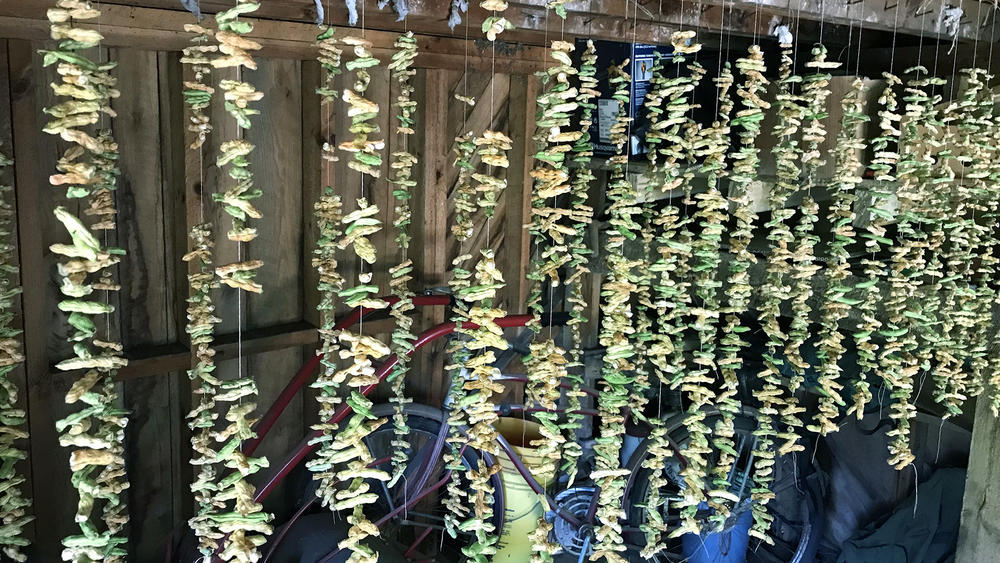
Section Branding
Header Content
Have You Ever Eaten Leatherbritches?
Primary Content
Have you ever eaten leatherbritches? Some of you might know exactly what we’re talking about. Others might wonder if we are encouraging you to eat a pair of pants. I can assure you we are not. And Salvation South editor Chuck Reece is here to tell you more precisely what we mean in this week’s commentary.

TRANSCRIPT:
Dear listeners, today I intend to speak with you about leather britches.
To those of you in rush hour traffic, please do not wreck your cars. I am not about to spend three minutes of your time talking about Freddie Mercury’s stage attire.
No. The leatherbritches I speak of are things you eat. If you grew up in the mountains of Appalachia, you might already know what I’m talking about. The rest of you, just stick with me.
Think for a second about the bowl of green beans that might sit on your classic Southern Sunday dinner table. Probably cooked for a few hours with a ham hock in there for seasoning. They get kind of mushy, but they're yummy because they're full of the flavor of that smoked pork.
Now dial that table back in time to the late 18th century, decades before a French chef named Nicolas Appert figured out how to preserve vegetables in sterile glass jars. So let’s say it’s the winter of 1776 and you decide you’d love a piping hot mess of green beans to eat. There are no fresh ones in the garden, of course, and there are no canned beans — because canning hadn’t been invented yet.
In those days, there was only one way to preserve your green beans over the winter. That was to take a needle and thread, and string every fresh green bean pod you had onto that thread. Then take your threads of green beans and hang them somewhere to dry in the sun. They would slowly shrivel up and turn leathery. And when you put two of them next to each other, they looked like a funny pair of pants.
And you called them…leatherbritches.
Now, I grew up in a household where leatherbritches were a thing. My dad had grown up eating them in the early 20th century. The whole Reece family had made and eaten leatherbritches for generations.
Eating them required you to cook some onions and garlic in bacon grease, then add a little salt pork and a ham hock, then your leatherbritches and water enough to cover the whole assembly. Then you’d cook them for at least three hours.
If leatherbritches are reconstituted and cooked correctly, like I just explained, they taste good, mostly thanks to the pork you cook them with. They taste only vaguely like green beans, kind of like smoked beans, I guess.
Please don’t take what I’ve said about food with a funny name as my attempt to make fun of this old foodway or the mountain people who came up with it and named it long ago. No, I tell you this story to honor the inventiveness and the hardiness of Southern folks who came before us.
Now if you’d like to learn more about the history, the making, and the eating of leatherbritches, we have a story about that for you in the online magazine I edit, Salvation South, right now. And you’ll even get to learn a bit about how that method of preserving beans can teach you something about preserving life itself.
Y’all come see us at SalvationSouth.com.
Salvation South editor Chuck Reece comments on Southern culture and values in a weekly segment that airs Fridays at 7:45 a.m. during Morning Edition and 4:44 p.m. during All Things Considered on GPB Radio. He also does an extended version of the podcast called Salvation South Deluxe each month. You can also find them here at GPB.org/Salvation-South and please download and subscribe on your favorite podcast platform as well.
Have you ever eaten leatherbritches? Some of you might know exactly what we’re talking about. Others might wonder if we are encouraging you to eat a pair of pants. I can assure you we are not. Salvation South editor Chuck Reece is here to tell you more precisely what we mean in this week's commentary.






